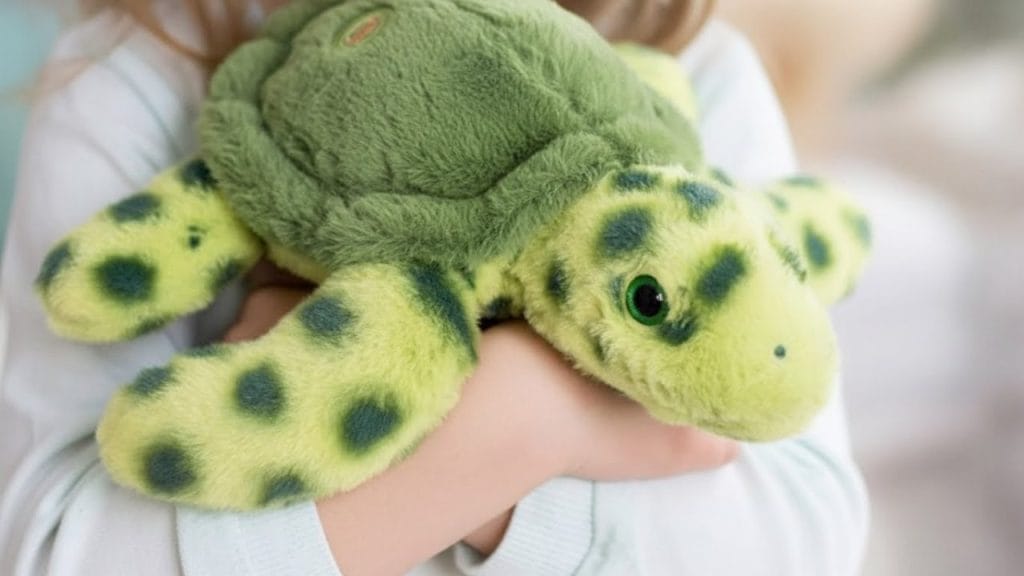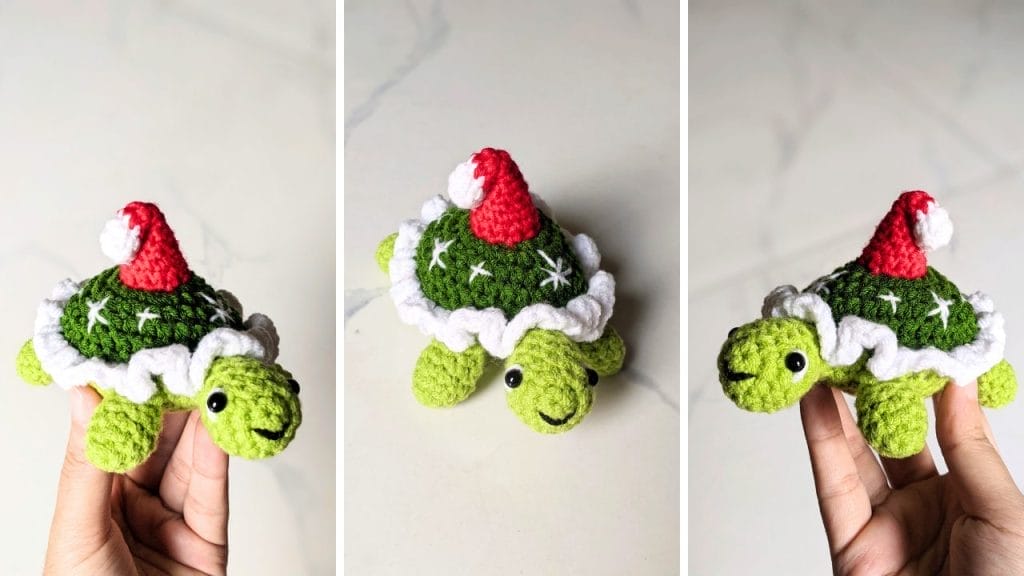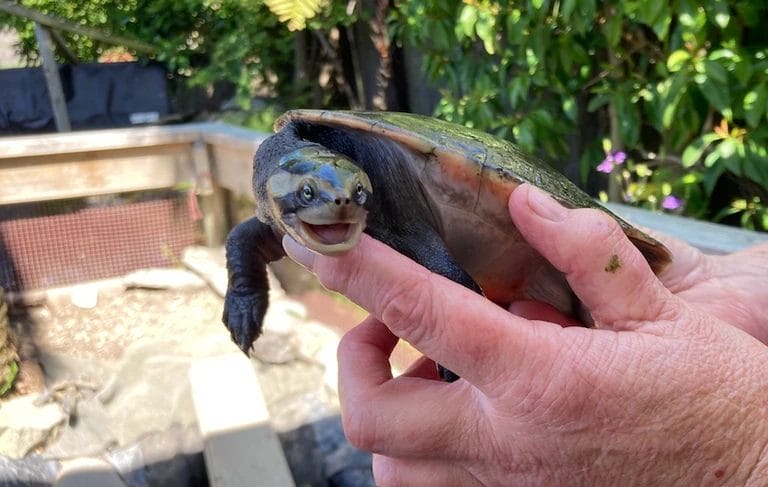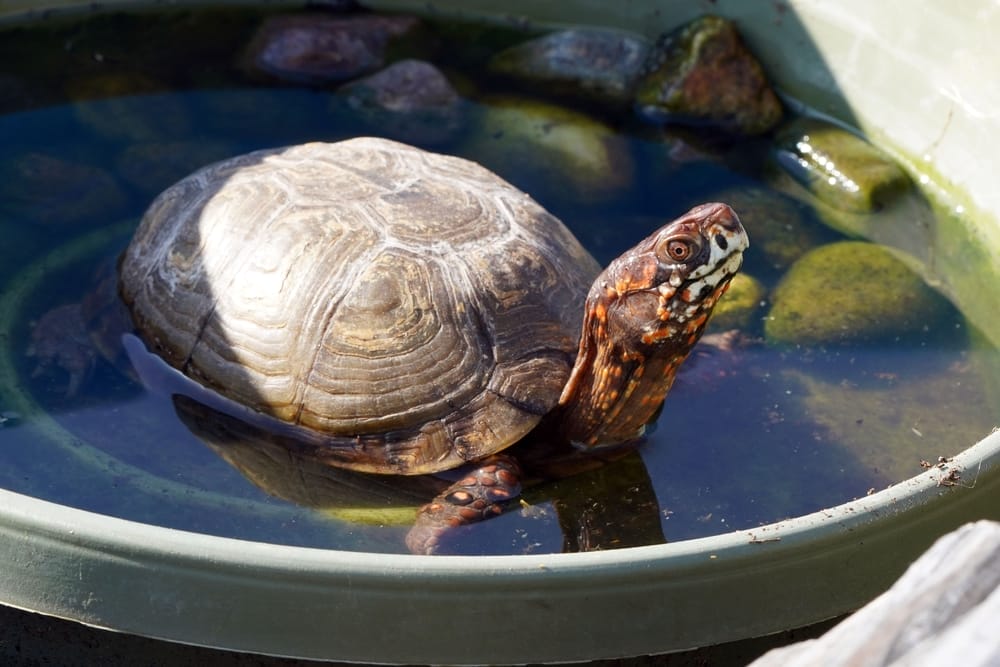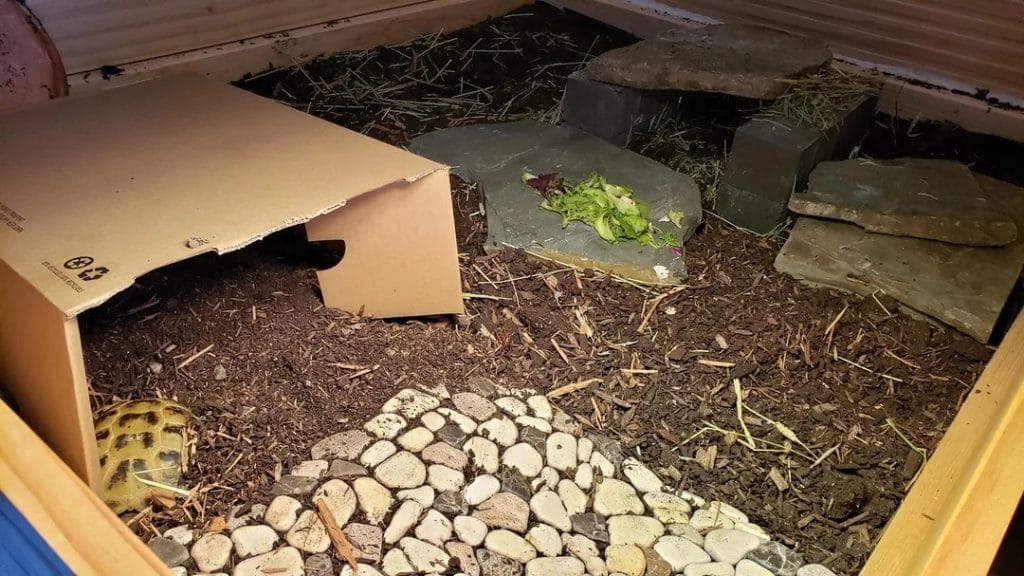44 Tortoise Safe Plants That Are Perfect For Feeding

This post was created with help from AI tools and carefully reviewed by a human (Muntaseer Rahman). For more on how we use AI on this site, check out our Editorial Policy.
Tortoises are pure vegetarians, and plants are an important part of their diet. But keepers often mistake selecting safe plants for their pets. Remember, toxic herbs or plants can make the tortoises ill and even choke them to death.
Safe plants for tortoise meals are:
- Houseplants (Boston fern, spider plant)
- Cactus
- Clover
- Collard green
- Daisy
- Dandelion
- Mustard green
- Gazania
- Geranium
- Hebe
- Hibiscus
- Nettle
- Pansies
- Plantain
- Petunia
- Succulents (aloe vera, agave, Echeverias)
- Mallows
- Weed (chickweed, bindweed, duckweed, hawkweed)
- Watercress, etc.
The list does not end here. Go through the below article for detailed information.
Worried a plant might be toxic? Use our free Tortoise Plant Safety Checker to find out instantly.
From Safe Plants to Balanced Diet
You now know which plants are safe. But how do you turn this knowledge into a healthy tortoise? Here’s the complete picture:
Step 1: Identify Your Species’ Diet Type
Mediterranean Tortoises (Hermann’s, Greek, Russian, Marginated):
- 80-90% weeds, grasses, and fibrous greens
- 10-20% leafy vegetables (collards, dandelion, plantain)
- 0-5% fruit (preferably none)
- High fiber, low protein, minimal sugar
Tropical Tortoises (Red-foot, Yellow-foot, Hingeback):
- 60-70% leafy greens and vegetables
- 15-20% fruit (more tolerant than other species)
- 10-15% protein sources (yes, these species eat some protein)
- More variety acceptable
Desert/Grazing Tortoises (Sulcata, Leopard, Desert):
- 70-90% grasses and hay
- 10-20% weeds and broadleaf plants
- 0-5% fruit and vegetables
- Very high fiber essential
Don’t know your species’ requirements? See our species-specific diet guide
Step 2: Add Calcium Supplementation
Plants alone don’t provide enough calcium for shell health. Period.
What you need:
- Calcium powder: Rep-Cal (without D3 for outdoor tortoises with natural sun, with D3 for indoor tortoises)
- Cuttlebone: Available in enclosure for self-regulated calcium intake
- Dusting schedule:
- Hatchlings/juveniles: Every feeding
- Adults: 2-3 times per week
Without calcium supplementation: Metabolic bone disease, soft shell, deformities, early death
Detailed supplementation guide: Food & Supplements
Step 3: Ensure Proper UVB Lighting
Calcium supplementation is useless if your tortoise can’t absorb it. UVB light enables vitamin D3 synthesis, which is required for calcium metabolism.
For indoor tortoises:
- ReptiSun 10.0 T5 HO or Arcadia D3 12%
- 12-18 inches above tortoise
- Replace every 6-12 months
- 10-12 hours daily
For outdoor tortoises:
- Natural sunlight provides UVB
- Ensure access to unfiltered sunlight (not through glass)
- Still need shade for temperature regulation
Complete UVB guide: UVB Lighting Requirements
Step 4: Use Proper Feeding Setup
How you present food matters as much as what you feed.
Feeding surface:
- Flat tile, slate, or ceramic dish
- Prevents substrate ingestion
- Easy to clean
- Keeps food elevated from moisture
Water dish:
- Shallow enough to enter/exit easily
- Deep enough for chin soaking
- Cleaned daily (tortoises defecate in water)
Feeding dishes guide: Food & Water Dishes
Step 5: Avoid Common Dietary Mistakes
Even with safe plants and proper supplementation, these mistakes cause problems:
- Feeding same foods every day – Causes nutritional imbalances
- Too much fruit – Disrupts gut flora, causes diarrhea
- Ignoring species requirements – Sulcatas need grass, not salads
- Skipping calcium – #1 cause of health problems
- Old or wilted plants – Lower nutrition, potential toxin buildup
- Overfeeding – Causes rapid growth, pyramiding
Complete mistake guide: Common Mistakes to Avoid
The Complete Nutrition Equation:
- Safe plants (this article)
- Species-appropriate ratios
- Calcium supplementation
- Proper UVB lighting
- Correct feeding setup
- Variety and rotation
Get all the details: Complete Tortoise Owner Essentials

44 Plants That Are Absolutely Safe For Tortoises
When you add a plant to a tortoise diet chart, check whether it is safe. Mistaking one plant for another can cost you your pet’s life.
I have included all common safe plants for tortoises below. Go through them when preparing the diet plan for the reptiles.
1. Aloe Vera/ Agave
See, aloe vera and agave have a perfect balance of nutrients and water content. Moreover, the succulent texture makes the plant more chewable for the tortoises.
Some reptiles may suffer from diarrhea after an aloe vera or agave diet. Therefore, keep an eye on the tortoise’s health when experimenting with the meals.
Other safe succulent plant options for tortoises are,
- Echeverias
- Mother of pearl
- Gasteria
- Haworthias, etc.
2. Aubretia
Both flowers and leaves of aubretia plants are included in the tortoise diet. Prepare a meal mixing these plants with other leaves and greens. The demand for aubretia plants is higher in the early spring.
3. Bindweed/ Chickweed/ Duckweed
All these weeds are safe for tortoises only when fed in moderation. For example, bindweed can have a hallucinogenic effect on reptiles.
Likewise, chickweed includes saponin, a harmful element that can hamper nutrient absorption in tortoises. Again, duckweed is high in protein, and excess protein causes pyramiding or shedding in the creatures.
Therefore, use these weeds only to supplement the meal, not as the main diet.
4. Bramble
Blackberry leaves, and flowers are also edible for tortoises. But some pets may find the taste unpleasant as the leaves contain tannins and astringent substances. Besides, experts suggest that the leaves and flowers of a sweet fruit may also carry a moderate sugar level.
Therefore, feed your tortoises bramble leaves and flowers after mixing them with other vegetables. Also, new leaves are more suitable for pets than old or fallen ones.
One more thing. Remove any thorns from the underside of the leaf before offering it to the pets.

5. Boston Fern
You can grow Boston fern in your tortoise’s indoor terrarium. These houseplants require a cool and humid environment with sufficient shade. Boston ferns have fast growth, but tortoises will nibble them occasionally, keeping the length cheeked.
6. Bromeliad
These houseplants are high in water content. Hence, offering your tortoises bromeliad in limited amounts can reverse dehydration.
7. Cactus
Desert tortoises are dependent on the cactus fruits, flowers, and pads as the plant is high in water content. Besides, cactus also includes minerals and vitamins in a limited percentage.
Safe cactus options for tortoises are,
- Fishhook barrel cactus
- Mistletoe cactus
- Dragon Fruit Cactus
- Easter cactus
- Christmas cactus, etc.
No matter which one you feed your tortoises, de-spine the cactus thoroughly beforehand. The spikes can injure the pets internally and externally.

8. Campanula
The low trailing campanula is a safe plant option for your reptiles. You can grow the campanula in a wired basket inside the tortoise enclosure or hand the plant overhead. The pets will enjoy munching on the leaves from time to time.
9. Clover
You will find clover throughout the year and so, it makes a fresh diet for the tortoises. Both the flowers and leaves can be utilized in the meal.
However, professionals suggest minding the clover percentage in the diet as the plant is high in protein and nitrate. Thus, overfeeding can cause health complexities, especially in baby tortoises.
10. Collard Green
Rich in vitamins (A, C, K), minerals (sodium, calcium, iron, magnesium, etc.), and fibers, collard greens can be a healthy vegetable for your tortoises. Though these greens include no toxic elements, add the vegetables to the pet’s diet in moderation. Also, make sure the meal has at least 2 different types of greens.
11. Cucumber
Professionals advise adding cucumbers to the tortoise diet occasionally. It is because cucumbers do not provide high nutrient content to pets. But yes, you can feed your tortoises this vegetable in moderate amounts to avoid dehydration.
12. Daisy
Reports suggest that daisies contain cyanogenic glycosides linamarin, a toxic that leads to terminal illness. Yet, some professionals give the daisies a green signal for the reptile’s meals. It is because no evidence indicates the plant’s toxicity for tortoises.
I strongly discourage you from feeding daisies to your pets. It will not harm to be on the safe side. Right?
13. Dandelion
Tortoises can eat almost all parts of dandelion (stem, leaves, flower). It is advised to add dandelion only twice or thrice a week to the pet’s diet. Apparently, the plant has a high percentage of oxalate, which may interrupt calcium absorption in tortoises.
14. Elm
White elm, Chinese elm, lacerback elm, Europe elm, etc., are commonly added to tortoise meals. Experts say the older or fallen leaves are toxic and should be avoided. But the fresh leaves are fine for the pets as long as you mix them with other items.

15. Forget Me Not
Your tortoises will enjoy the forget-me-not flowers and leaves. But newbies often mistake identifying safe plants. Remember, only the woodland and water forget-me-not (with a yellow middle) are non-poisonous. The Chinese forget-me-not is toxic and harms the tortoises.
16. Gazania
If you are up to building a low-effort tortoise garden, the gazania flower plant should definitely be on your list. You can offer your pets one or two leaves and flowers every day, fresh from the garden.
Gazania is not toxic. But the plant may cause irritation and discomfort in the tortoises and other pets if they feast on the leaves or flowers.
17. Geranium
I have seen owners debating whether to feed the tortoises geranium flowers or leaves. Well, you can offer the tortoises both the plant parts, but only as a supplement to the main meals. While some tortoises love munching geranium leaves and flowers, others hate the taste.
18. Hebe
Honestly, hebe plants can be an excellent addition to any tortoise pen. These large shrubs act as both shelter and snack for the pets. You can feed the flowers on a daily basis and offer the leaves occasionally.

19. Hibiscus
The hibiscus goes by different names. Such as shoe flower, China rose, Chinese hibiscus, Mediterranean hibiscus, and shoeblack plant.
Hibiscus flowers are favorites of the tortoises. You can offer the leaves once in a while to bring variety.
Though the tropical hibiscus is safe, the Hibiscus Syriacus is toxic. Do not get confused between these two. One key distinguishing characteristic is that the former has a leathery leaf texture.
20. Honeysuckle
Honestly, I do not recommend feeding honeysuckle to the tortoises. It is because the berries are toxic, and the leaves also include a high percentage of tannins and saponins. Thus, though you can offer honeysuckle flowers at a moderate rate, the plant can never be the pet’s staple food.
21. Hosta
Do not grow hosta in your house if you are also raising cats or dogs. The plant is toxic for these pets. In fact, the whole diet plan will backfire if you add hosta flowers and leaves as staples.
I advise feeding the tortoises hosta leaves, flowers, and stems only to bring variety to the meal.
22. Iceberg Lettuce
Your tortoises may be a fan of iceberg lettuces, but these leaves contain no significant minerals. The high water content can be a reason to offer these to your pets only in summer.
Never fill your tortoise with iceberg lettuce. Otherwise, the pet will suffer from mineral deficiency.
23. Kale
Because of the goitrogenic effect, kale is not a favorite diet option for most keepers. But the vegetable also includes a high iodine percentage to balance the condition. Thus, kale is definitely a safe food for tortoises when fed occasionally.
24. Lamb Lettuce
This lettuce goes into the mixed salad prepared for tortoises, and there is no feeding restriction. Lamb lettuces are available in the grocery store at a cheap price. Also, you can grow this lettuce in the pot, garden, or backyard.

25. Lemon Balm
These scented herbs can entice the tortoise’s appetite even more. But be careful about the quantity.
Though lemon balm has no toxins, it contains eugenol, a potential liver-damaging element. Also, too much of this herb may affect the thyroid gland.
26. Lilac
Tortoises seem to like lilac because of the pleasant smell. Both the leaves and flowers of this plant are edible.
27. Mallow
You will find mallow weed all around the year. So, the mallow leaves and flowers can be a fresh addition to the tortoise’s existing diet chart.
Hibiscus and hollyhock plants also fall in the mallow family. The colorful flowers and broad hollyhock leaves can be a tasty addition to the pet’s meal.
28. Marigold
Only the pot and field marigolds are safe for tortoises. In fact, these flowers carry antioxidants, which promote a strong immunity in pets.
French marigold, conversely, is toxic and causes health complexities in tortoises.
29. Mustard
Common mustard plants for tortoises are garlic mustard and hedge mustard. Unfortunately, these plants contain goitrogens. As a result, excessive mustard in the meals will lead to kidney failure and thyroid issues in the tortoises.
However, mixing mustard with other leaves and flowers will minimize the negative effect.
30. Nettle
Dead Nettle or stinging nettles are safe for tortoises. But make sure the nettles are pesticide-free and fresh. Some advantages of dead nettle for pets are,
- Reduction of inflammation
- Minimization of chronic diseases
- Building solid immunity, etc.
Well, the stinging nettles have toxic hair on the leaves, which may irritate the tortoise’s throat. However, such discomfort is bearable, and reptiles prefer chewing the raw stinging nettles because of the texture.
Dead nettles, on the contrary, offer no such irritation. Also, these leaves include less oxalate percentage than the stinging nettles. Hence, dead nettles will be a safe option for the tortoises.
Two popular dead nettle varieties are yellow dead nettle and white dead nettle.
31. Pansies
Viola and pansies are fantastic autumn food for tortoises. You should plant the pansies during the summer to enjoy the flowers later in autumn. However, refrain from offering freshly bought pansy flowers or leaves to your tortoises, as they can be sprayed with pesticides.
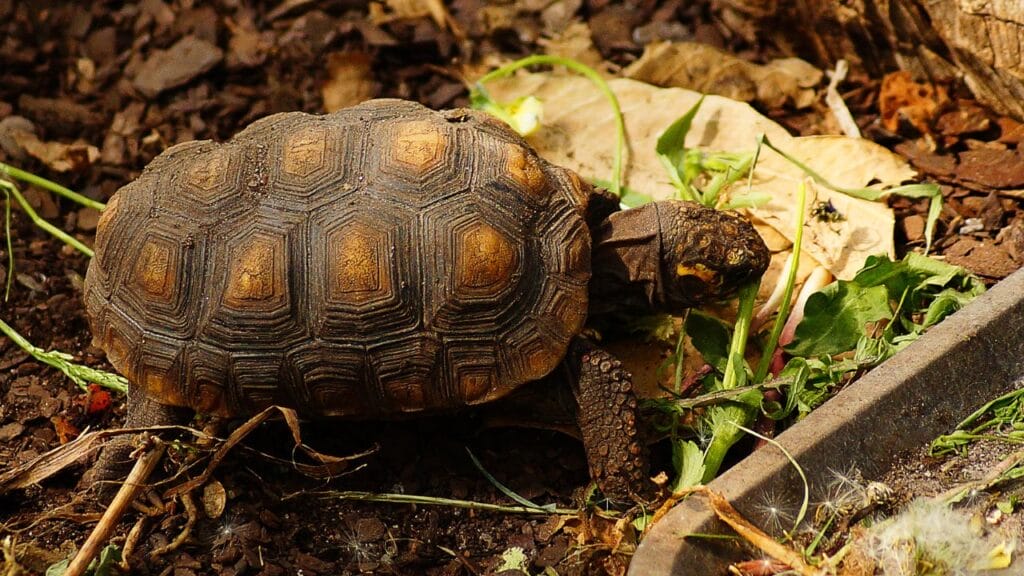
32. Petunia
Tortoises find the petunia leaves and star-shaped flowers extremely yummy. However, there is a rumor that this plant may carry traces of toxins.
Well, no reports have proven petunia’s toxic characteristics in a tortoise’s diet. Yet, you should add the petunia flower or leaf to the pet’s meal in a limited amount.
33. Plantains
You can feed your tortoises plantains without worrying about the side effects. Both the broad and narrow-leaf plantains are rich in vitamins (A, C, K), minerals (zinc, potassium), and nutrients. Hence, mixing these with a regular diet will promote good health.
Furthermore, plantains have anti-bacterial, anti-microbial, and anti-inflammatory effects. It means the tortoises have more protection against infectious diseases.
34. Red Sorrel/ Sheep Sorrel
Sorrels are considered a perfect diet for tortoises because of their high nutrient value. Moreover, you can grow the sorrels in the pot or backyard with zero care.
The only concern with sorrels is their oxalate level. A higher percentage of oxalic acid in vegetables or plants can cause mouth irritation and mess up the digestive system.
Well, the experts suggest not to worry about the oxalate level as long as you feed the pets various vegetables. Yet, I recommend you should consider the quantity and never force the tortoises to feast on sorrels.
35. Rocket (Arugula, Roucola, Salad Rocket)
The vitamin and nutrient-rich arugula, rucola, and salad rockets are favorites for Sulcata tortoises and other species. Owners also prefer these brassicas as they are easy to grow in the garden.
However, you should not feed your tortoise arugula or rucola every day. These plants include goitrogen, which may lead to bladder or kidney stones in pets. Therefore, only add moderate arugula to your tortoise’s diet.

36. Rose
Both rose leaves and petals are safe for tortoises. You should avoid feeding the tortoises rose blooms and leaves sprayed with pesticides.
37. Self Heal
Many keepers doubt that self heal is not edible for tortoises. But no, the plants are perfect for pets when fed in moderate amounts, occasionally.
38. Spider Plant
You can grow spider plants inside the tortoise’s indoor tank. Spider plants are not suitable as a staple food. But you have to mix it with other greens and veggies.
39. Thistle
Sow thistle, bull thistle, scotch thistle, bull’s thistle, etc., are completely fine and non-toxic. Growing thistles in your backyard is the easiest gardening job as it requires low maintenance.
When feeding the tortoises, snip the bigger thistle spines into small pieces. Otherwise, the pets will struggle to munch on the weed.
40. Turtle Vein
Callisia Repens or turtle vein is a popular diet option for your tortoises. The plant contains calcium oxalate in a limited percentage, which is safe for reptiles. Yet, offer your tortoises these turtle veins in a moderate amount to avoid unnecessary scenarios.
41. Vetches
Kidney vetches are non-toxic plant options for tortoises only when offered in moderation. The legumes are high in protein. So, the excess vetch in the diet may lead to pyramiding or shedding in the pets.
Besides, vetches have a laxative effect, which may upset the tortoise’s stomach. Hence, do not use this legume as a pet’s staple diet.
42. Violets
African violets, dog violets, and sweet violets are edible and safe for your pets. Do not make the meals boring with only one type of violet. Instead, mix the broad leaf with other greens to prepare a yummy diet for the reptiles.
43. Watercress
You may not like nasturtium leaves in your salad. But tortoises do not mind either the leaves or the flowers. Add the watercress to the main meal as an additional or use it as a snack for the pets.
44. Other Safe Plant Options To Explore
- Coleus
- Creeping inch plant
- Hawkbit
- Hawkbeard
- Hawkweed
- Prayer plant
- Tradescantia
- Trefoil
- Yucca
This Hilarious Turtle Book Might Know Your Pet Better Than You Do
Let’s be real—most turtle care guides feel like reading a textbook written by a sleep-deprived zookeeper.
This one’s not that.
Told from the snarky point of view of a grumpy, judgmental turtle, 21 Turtle Truths You’ll Never Read in a Care Guide is packed with sarcasm, sass, and surprisingly useful insights.
And hey—you don’t have to commit to the whole thing just yet.
Grab 2 free truths from the ebook and get a taste of what your turtle really thinks about your setup, your food choices, and that weird plastic palm tree.
It’s funny, it’s honest, and if you’ve ever owned a turtle who glares at you like you’re the problem—you’ll feel seen.
20 Safe Grasses For Tortoises
Of course, plants make up a significant portion of the tortoise’s diet, and so do grasses. In fact, grasses are the main meal item for many tortoise species. For example, the Sulcata tortoise’s diet includes 70 – 90% grasses.
The safe grass list for tortoises is as follows,
- Arizona fescue
- Barley grass
- Big blue storm grass
- Buffalo grass
- Blue grama
- Carex sedge
- Couch grass
- Creeping red fescue
- Dallisgrass
- Fescue grass
- Fountain grass
- Kentucky bluegrass
- Lawn grass
- Pampus grass
- Sheep fescue
- Timothy grass
- Oat grass
- Rye grass
- Western wheatgrass
- Wheatgrass
Click here to explore the safe places to buy grasses for tortoises.

6 Fruits That Are Suitable For Tortoises
Tortoises do enjoy a fruity treat once in a while. That is why you have to consider safe and non-toxic fruit options for pets.
Fruits are usually high in sugar content. Unfortunately, tortoises can not process sugar very well and suffer from diarrhea. Therefore, add fruits in small portions to the pet’s meals.
Some tasty fruit options for tortoises are,
1. Apple
While many fruits contain high sugar content, apples are the opposite. These fruits are low in sugar and calories. Besides, apples carry a high amount of antioxidants, fibers, vitamins, and minerals.
Use apples only as a treat rather than a daily meal. Also, do not forget to remove the pips, which are high in cyanide toxins.
2. Banana
For us, bananas may seem a safe choice, but it is the opposite for tortoises. These fruits are high in starch, sugar, and potassium. Nutrient intakes in such a percentage can cause the tortoise an upset stomach and abdomen pain.
Hence, do not offer bananas to the tortoise if it can not handle fruits.
3. Pears
If your tortoise loves a fruity treat, you can offer it pears in small quantities. Chop the fruit and remove the seeds/pips before feeding the pets.
4. Melons
Fruits that belong to this group are,
- Cantaloupe
- Watermelon
- Honeydew
- Mask melon
- Ogen melon
- Galia
As you know, tortoise’s digestive systems do not cope well with high sugar. Therefore, melons should only be on the pet’s meal occasionally. That too in limited quantities.

5. Berries
Tortoises are absolute fans of berries. You can select any type of berries for the pets, for example, strawberry, blueberry, raspberry, blackberry, mulberry, marionberry, huckleberry, etc. However, only use this fruit as a treat, not a daily meal.
Berry leaves can also be a good feed for tortoises.
6. More Fruits For Tortoises
- Mango
- Resin
- Prune
- Date
- Guava
- Apricot
- Peach
- Grape
- Kiwi
- Fig
- Papaya
- Cherry
- Pear
- Orange
6 Toxic Plants That You Must Avoid For Tortoises
Tortoises may eat whatever you bring to the table. But their sensitive digestive system can not process and cancel out the toxic elements from the foods.
Hence, it is your responsibility to identify and eliminate the poisonous plants, grasses, weeds, vegetables, etc., from the diet plan. Here are some examples of toxic plants for tortoises,
1. Apple Leaf
Though apple is an excellent treat for tortoises, the tree leaf can be proven toxic. Apparently, as the apple leaf gets older, they generate a cyanic poisonous compound. Therefore, nibbling on the leaves may sicken the pets.
2. Celery
Well, celery is a controversial food item for tortoises. While some keepers believe feeding the pets celery in small amounts will cause no harm, others disagree.
Apparently, celery contains oxalates, which may cause internal irritation. So, you better consult the vet before adding this vegetable to the meal.
3. Crocuses/ Daffodils/ Foxgloves/ Peonies
All these plants are toxic and should be avoided at any cost. Even a few bites on the leaves are enough to make the tortoises ill. After ingesting these plants, the pet will experience diarrhea, vomiting, and convulsion. In serious cases, the pet’s heart may stop for a moment.
4. Peace Lily
White Anthurium, Spath, and Spathe flowers are commonly known as peace lilies. As per the research, these plants cause irritation, itchiness, and a burning sensation in the animal’s mouth.
Though such effects are not confirmed for tortoises, avoiding the peace lilies altogether is better.
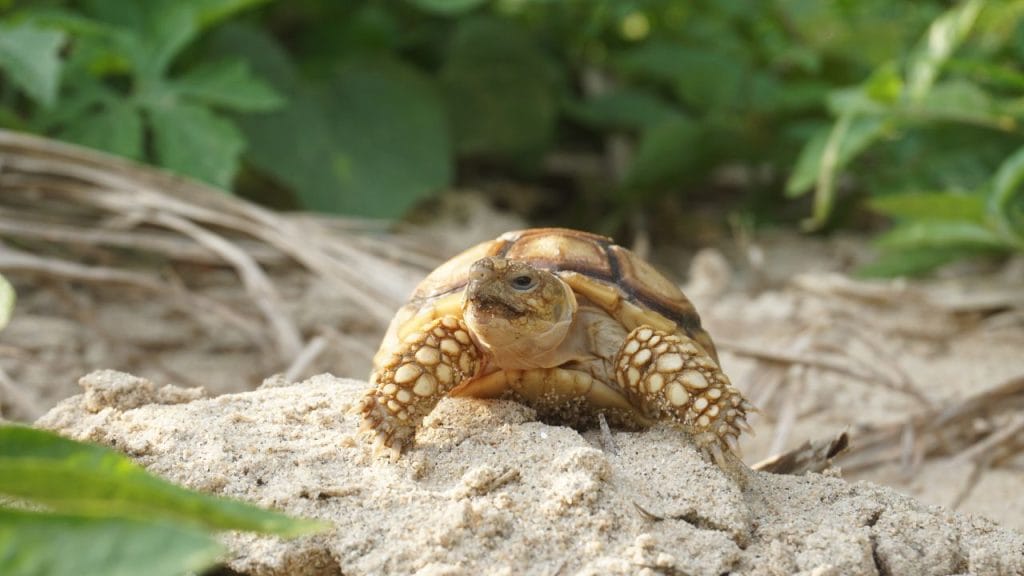
5. Rhubarb
Like celery, rhubarb also contains oxalate crystals. Therefore, you better avoid offering this vegetable to pets.
6. More Toxic Plants
- Aconite
- Azaleas
- Bleeding heart
- Euphorbias
- Hellebores
- Hepercium
- Lobelia
- Lupin
- Olender
- Peony
- Periwinkle
- Mistletoe
- Tobacco plant
- Tomato leaf and plant
- Ragwort
- Rhododendrons
Before You Go…
The safe plant list is of no use if you can not utilize it. Drafting a balanced meal and ideal feeding routine is very important to raise healthy and strong tortoises. The attached article below will guide you in preparing a meal schedule and plan for the pets.
The Guide To Feeding A Tortoise [Safe Food List]

About Author
Muntaseer Rahman started keeping pet turtles back in 2013. He also owns the largest Turtle & Tortoise Facebook community in Bangladesh. These days he is mostly active on Facebook.






